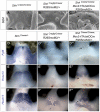Temporal and spatial dissection of Shh signaling in genital tubercle development
- PMID: 19906863
- PMCID: PMC2778743
- DOI: 10.1242/dev.039768
Temporal and spatial dissection of Shh signaling in genital tubercle development
Abstract
Genital tubercle (GT) initiation and outgrowth involve coordinated morphogenesis of surface ectoderm, cloacal mesoderm and hindgut endoderm. GT development appears to mirror that of the limb. Although Shh is essential for the development of both appendages, its role in GT development is much less clear than in the limb. Here, by removing Shh at different stages during GT development in mice, we demonstrate a continuous requirement for Shh in GT initiation and subsequent androgen-independent GT growth. Moreover, we investigated the Hh responsiveness of different tissue layers by removing or activating its signal transducer Smo with tissue-specific Cre lines, and established GT mesenchyme as the primary target tissue of Shh signaling. Lastly, we showed that Shh is required for the maintenance of the GT signaling center distal urethral epithelium (dUE). By restoring Wnt-Fgf8 signaling in Shh(-/-) cloacal endoderm genetically, we revealed that Shh relays its signal partly through the dUE, but regulates Hoxa13 and Hoxd13 expression independently of dUE signaling. Altogether, we propose that Shh plays a central role in GT development by simultaneously regulating patterning of the cloacal field and supporting an outgrowth signal.
Figures







Similar articles
-
Multiphasic and tissue-specific roles of sonic hedgehog in cloacal septation and external genitalia development.Development. 2009 Dec;136(23):3949-57. doi: 10.1242/dev.042291. Development. 2009. PMID: 19906862 Free PMC article.
-
Dosage-dependent hedgehog signals integrated with Wnt/beta-catenin signaling regulate external genitalia formation as an appendicular program.Development. 2009 Dec;136(23):3969-78. doi: 10.1242/dev.039438. Development. 2009. PMID: 19906864 Free PMC article.
-
Bmp4 is an essential growth factor for the initiation of genital tubercle (GT) outgrowth.Congenit Anom (Kyoto). 2020 Jan;60(1):15-21. doi: 10.1111/cga.12326. Epub 2019 Feb 17. Congenit Anom (Kyoto). 2020. PMID: 30714224
-
Regulatory roles of epithelial-mesenchymal interaction (EMI) during early and androgen dependent external genitalia development.Differentiation. 2019 Nov-Dec;110:29-35. doi: 10.1016/j.diff.2019.08.004. Epub 2019 Sep 11. Differentiation. 2019. PMID: 31590136 Review.
-
Sonic hedgehog regulates branching morphogenesis in the mammalian lung.Curr Biol. 1998 Sep 24;8(19):1083-6. doi: 10.1016/s0960-9822(98)70446-4. Curr Biol. 1998. PMID: 9768363 Review.
Cited by
-
GLI3 resides at the intersection of hedgehog and androgen action to promote male sex differentiation.PLoS Genet. 2020 Jun 4;16(6):e1008810. doi: 10.1371/journal.pgen.1008810. eCollection 2020 Jun. PLoS Genet. 2020. PMID: 32497091 Free PMC article.
-
The role of sonic hedgehog-Gli2 pathway in the masculinization of external genitalia.Endocrinology. 2011 Jul;152(7):2894-903. doi: 10.1210/en.2011-0263. Epub 2011 May 17. Endocrinology. 2011. PMID: 21586556 Free PMC article.
-
Requirement for basement membrane laminin α5 during urethral and external genital development.Mech Dev. 2016 Aug;141:62-69. doi: 10.1016/j.mod.2016.05.004. Epub 2016 May 18. Mech Dev. 2016. PMID: 27208857 Free PMC article.
-
Analysis of genitourinary anomalies in patients with VACTERL (Vertebral anomalies, Anal atresia, Cardiac malformations, Tracheo-Esophageal fistula, Renal anomalies, Limb abnormalities) association.Congenit Anom (Kyoto). 2011 Jun;51(2):87-91. doi: 10.1111/j.1741-4520.2010.00303.x. Congenit Anom (Kyoto). 2011. PMID: 21235632 Free PMC article.
-
Adult Gli2+/-;Gli3Δ699/+ Male and Female Mice Display a Spectrum of Genital Malformation.PLoS One. 2016 Nov 4;11(11):e0165958. doi: 10.1371/journal.pone.0165958. eCollection 2016. PLoS One. 2016. PMID: 27814383 Free PMC article.
References
-
- Allard P., Tabin C. J. (2009). Achieving bilateral symmetry during vertebrate limb development. Semin. Cell Dev. Biol. 20, 479-484 - PubMed
-
- Cohn M. J. (2004). Developmental genetics of the external genitalia. Adv. Exp. Med. Biol. 545, 149-157 - PubMed
-
- Echelard Y., Epstein D. J., St-Jacques B., Shen L., Mohler J., McMahon J. A., McMahon A. P. (1993). Sonic hedgehog, a member of a family of putative signaling molecules, is implicated in the regulation of CNS polarity. Cell 75, 1417-1430 - PubMed
Publication types
MeSH terms
Substances
Grants and funding
LinkOut - more resources
Full Text Sources
Molecular Biology Databases
Miscellaneous

